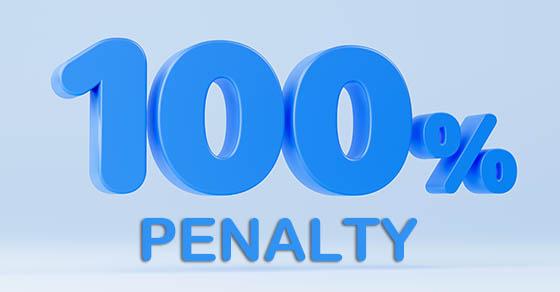Small business alert: Watch out for the 100% penalty
Some tax sins are much worse than others. An example is failing to pay over federal income and employment taxes that have been withheld from employees’ paychecks. In this situation, the IRS can assess the trust fund recovery penalty, also called the 100% penalty, against any responsible person.
It’s called the 100% penalty because the entire unpaid federal income and payroll tax amounts can be assessed personally as a penalty against a responsible person, or several responsible persons.
Determining responsible person status
Since the 100% penalty can only be assessed against a so-called responsible person, who does that include? It could be a shareholder, director, officer or employee of a corporation; a partner or employee of a partnership; or a member (owner) or employee of an LLC. To be hit with the penalty, the individual must:
- Be responsible for collecting, accounting for, and paying over withheld federal income and payroll taxes, and
- Willfully fail to pay over those taxes.
Willful means intentional, deliberate, voluntary and knowing. The mere authority to sign checks when directed to do so by a person who is higher-up in a company doesn’t by itself establish responsible person status. There must also be knowledge of and control over the finances of the business. However, responsible person status can’t be deflected simply by assigning signature authority over bank accounts to another person in order to avoid exposure to the 100% penalty. As a practical matter, the IRS will look first and hard at individuals who have check-signing authority.
What courts examine
The courts have examined several factors beyond check-signing authority to determine responsible person status. These factors include whether the individual:
- Is an officer or director,
- Owns shares or possesses an entrepreneurial stake in the company,
- Is active in the management of day-to-day affairs of the company,
- Can hire and fire employees,
- Makes decisions regarding which, when and in what order outstanding debts or taxes will be paid, and
- Exercises daily control over bank accounts and disbursement records.
Real-life cases
The individuals who have been targets of the 100% penalty are sometimes surprising. Here are three real-life situations:
Case 1: The operators of an inn failed to pay over withheld taxes. The inn was an asset of an estate. The executor of the estate was found to be a responsible person.
Case 2: A volunteer member of a charitable organization’s board of trustees had knowledge of the organization’s tax delinquency. The individual also had authority to decide whether to pay the taxes. The IRS determined that the volunteer was a responsible person.
Case 3: A corporation’s newly hired CFO became aware that the company was several years behind in paying withheld federal income and payroll taxes. The CFO notified the company’s CEO of the situation. Then, the new CFO and the CEO informed the company’s board of directors of the problem. Although the company apparently had sufficient funds to pay the taxes in question, no payments were made. After the CFO and CEO were both fired, the IRS assessed the 100% penalty against both of them for withheld but unpaid taxes that accrued during their tenures. A federal appeals court upheld an earlier district court ruling that the two officers were responsible persons who acted willfully by paying other expenses instead of the withheld federal taxes. Therefore, they were both personally liable for the 100% penalty.
Don’t be tagged
If you participate in running a business or any entity that hasn’t paid over federal taxes that were withheld from employee paychecks, you run the risk of the IRS tagging you as a responsible person and assessing the 100% penalty. If this happens, you may ultimately be able to prove that you weren’t a responsible person. But that can be an expensive process. Consult your tax advisor about what records you should be keeping and other steps you should be taking to avoid exposure to the 100% penalty.
© 2025












